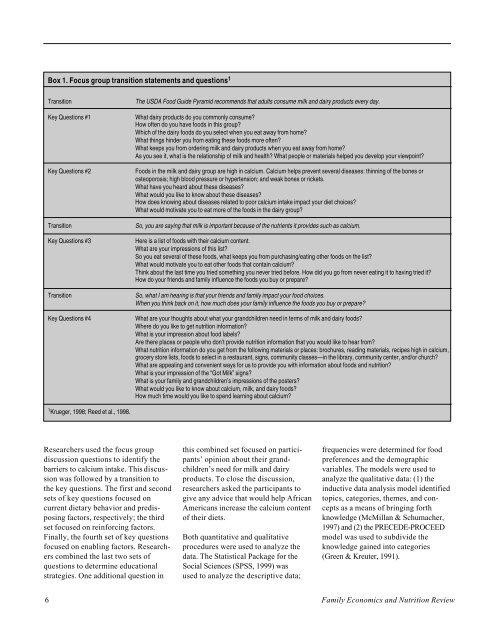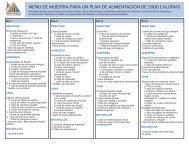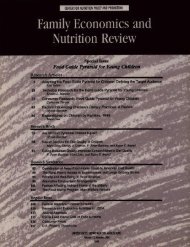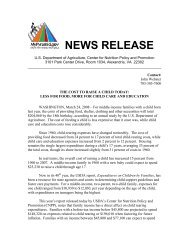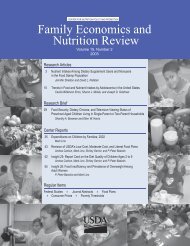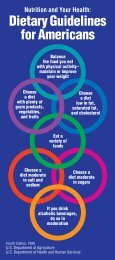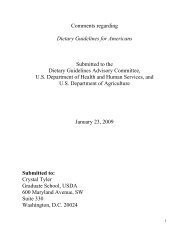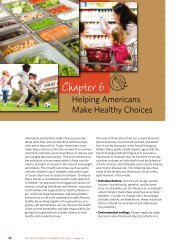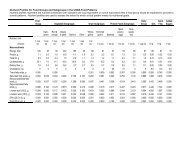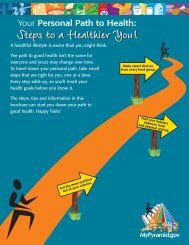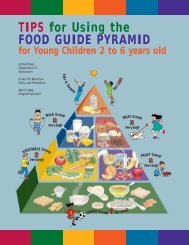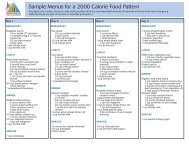Elderly Nutrition - Center for Nutrition Policy and Promotion - US ...
Elderly Nutrition - Center for Nutrition Policy and Promotion - US ...
Elderly Nutrition - Center for Nutrition Policy and Promotion - US ...
Create successful ePaper yourself
Turn your PDF publications into a flip-book with our unique Google optimized e-Paper software.
Box 1. Focus group transition statements <strong>and</strong> questions 1<br />
Transition<br />
Key Questions #1<br />
Key Questions #2<br />
Transition<br />
Key Questions #3<br />
Transition<br />
Key Questions #4<br />
The <strong>US</strong>DA Food Guide Pyramid recommends that adults consume milk <strong>and</strong> dairy products every day.<br />
What dairy products do you commonly consume?<br />
How often do you have foods in this group?<br />
Which of the dairy foods do you select when you eat away from home?<br />
What things hinder you from eating these foods more often?<br />
What keeps you from ordering milk <strong>and</strong> dairy products when you eat away from home?<br />
As you see it, what is the relationship of milk <strong>and</strong> health? What people or materials helped you develop your viewpoint?<br />
Foods in the milk <strong>and</strong> dairy group are high in calcium. Calcium helps prevent several diseases: thinning of the bones or<br />
osteoporosis; high blood pressure or hypertension; <strong>and</strong> weak bones or rickets.<br />
What have you heard about these diseases?<br />
What would you like to know about these diseases?<br />
How does knowing about diseases related to poor calcium intake impact your diet choices?<br />
What would motivate you to eat more of the foods in the dairy group?<br />
So, you are saying that milk is important because of the nutrients it provides such as calcium.<br />
Here is a list of foods with their calcium content.<br />
What are your impressions of this list?<br />
So you eat several of these foods, what keeps you from purchasing/eating other foods on the list?<br />
What would motivate you to eat other foods that contain calcium?<br />
Think about the last time you tried something you never tried be<strong>for</strong>e. How did you go from never eating it to having tried it?<br />
How do your friends <strong>and</strong> family influence the foods you buy or prepare?<br />
So, what I am hearing is that your friends <strong>and</strong> family impact your food choices.<br />
When you think back on it, how much does your family influence the foods you buy or prepare?<br />
What are your thoughts about what your gr<strong>and</strong>children need in terms of milk <strong>and</strong> dairy foods?<br />
Where do you like to get nutrition in<strong>for</strong>mation?<br />
What is your impression about food labels?<br />
Are there places or people who don’t provide nutrition in<strong>for</strong>mation that you would like to hear from?<br />
What nutrition in<strong>for</strong>mation do you get from the following materials or places: brochures, reading materials, recipes high in calcium,<br />
grocery store lists, foods to select in a restaurant, signs, community classes—in the library, community center, <strong>and</strong>/or church?<br />
What are appealing <strong>and</strong> convenient ways <strong>for</strong> us to provide you with in<strong>for</strong>mation about foods <strong>and</strong> nutrition?<br />
What is your impression of the “Got Milk” signs?<br />
What is your family <strong>and</strong> gr<strong>and</strong>children’s impressions of the posters?<br />
What would you like to know about calcium, milk, <strong>and</strong> dairy foods?<br />
How much time would you like to spend learning about calcium?<br />
1 Krueger, 1998; Reed et al., 1998.<br />
Researchers used the focus group<br />
discussion questions to identify the<br />
barriers to calcium intake. This discussion<br />
was followed by a transition to<br />
the key questions. The first <strong>and</strong> second<br />
sets of key questions focused on<br />
current dietary behavior <strong>and</strong> predisposing<br />
factors, respectively; the third<br />
set focused on rein<strong>for</strong>cing factors.<br />
Finally, the fourth set of key questions<br />
focused on enabling factors. Researchers<br />
combined the last two sets of<br />
questions to determine educational<br />
strategies. One additional question in<br />
this combined set focused on participants’<br />
opinion about their gr<strong>and</strong>children’s<br />
need <strong>for</strong> milk <strong>and</strong> dairy<br />
products. To close the discussion,<br />
researchers asked the participants to<br />
give any advice that would help African<br />
Americans increase the calcium content<br />
of their diets.<br />
Both quantitative <strong>and</strong> qualitative<br />
procedures were used to analyze the<br />
data. The Statistical Package <strong>for</strong> the<br />
Social Sciences (SPSS, 1999) was<br />
used to analyze the descriptive data;<br />
frequencies were determined <strong>for</strong> food<br />
preferences <strong>and</strong> the demographic<br />
variables. The models were used to<br />
analyze the qualitative data: (1) the<br />
inductive data analysis model identified<br />
topics, categories, themes, <strong>and</strong> concepts<br />
as a means of bringing <strong>for</strong>th<br />
knowledge (McMillan & Schumacher,<br />
1997) <strong>and</strong> (2) the PRECEDE-PROCEED<br />
model was used to subdivide the<br />
knowledge gained into categories<br />
(Green & Kreuter, 1991).<br />
6 Family Economics <strong>and</strong> <strong>Nutrition</strong> Review


